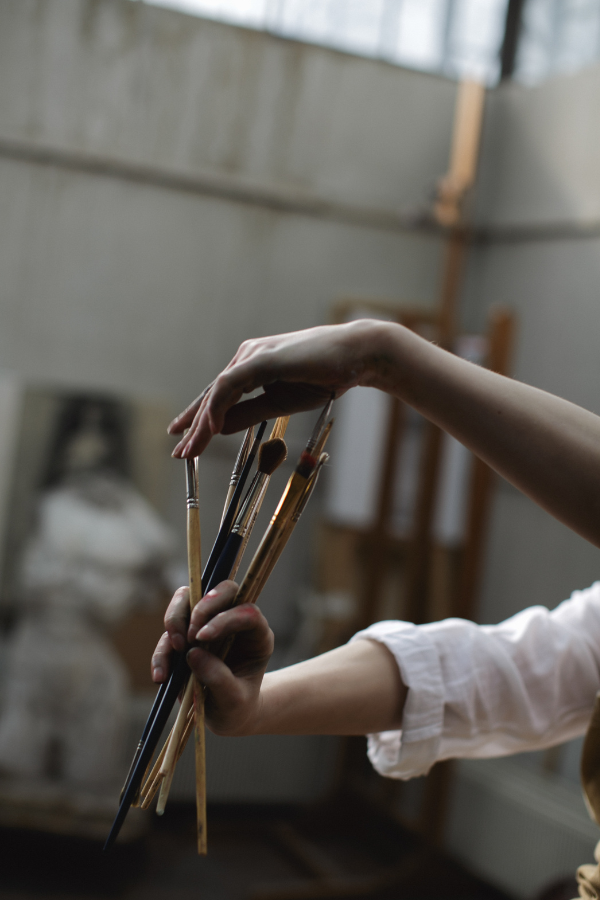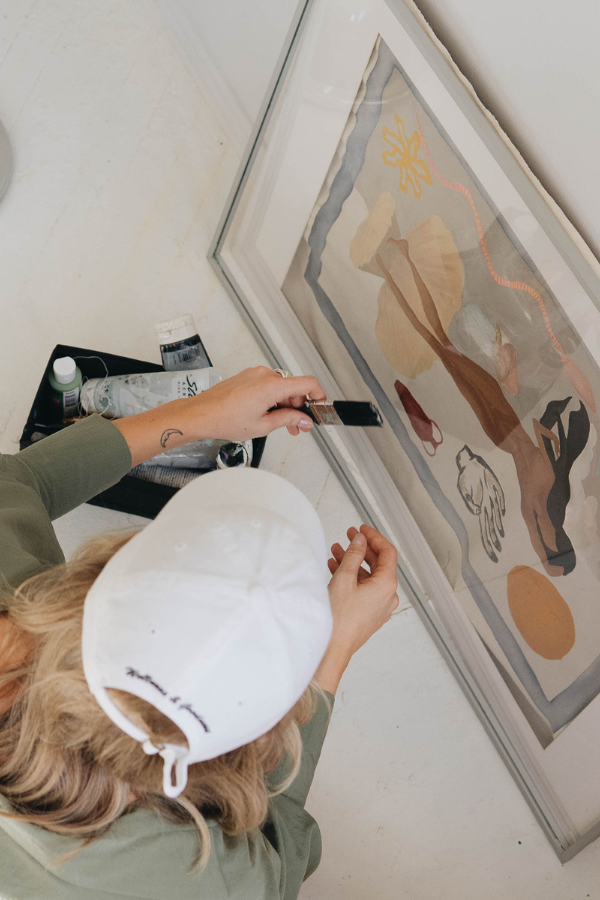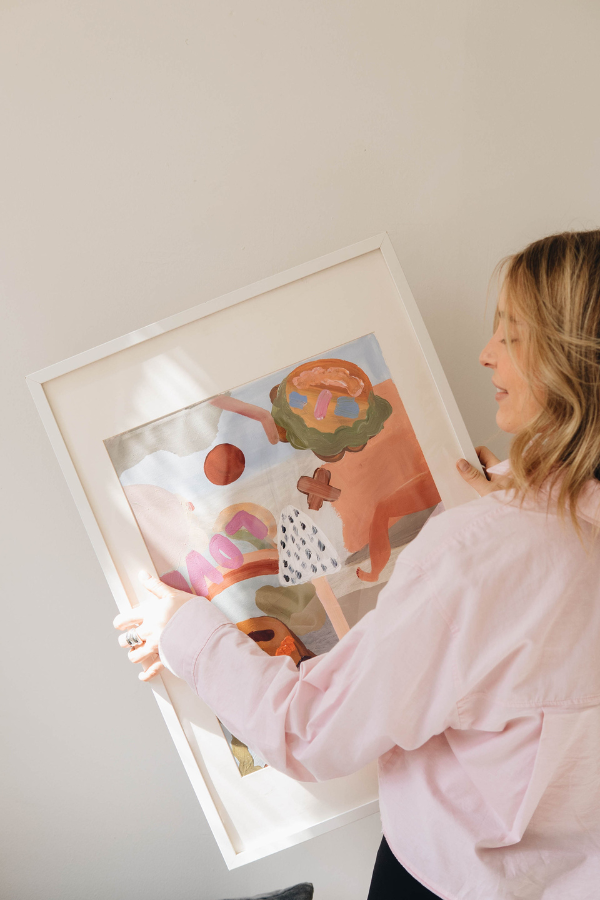

All About Art Licensing: How Artists Can Diversify Their Income Streams
Summary
Reflection Questions
Journal Prompt
From greeting cards to home décor, creating art for licensing can be incredibly lucrative. A fine artist might turn to licensing at some point during their art career as a way of ensuring regular income, expanding their reach in the art industry, or finding collaborators. Art licensing—while lucrative—is nuanced and layered with both potential rewards and inherent challenges. As artists navigate the licensing industry, understanding its value and being vigilant about its pitfalls becomes paramount. In this article, we consider the benefits of art licensing and out line the steps artists must take to protect their work and reputation.
What is Art Licensing?


Art licensing is a formalized process in which artists grant third parties the right to reproduce and utilize their creative works across diverse formats. Essentially, it involves an agreement where the artist allows for their original works to be replicated—either digitally or in physical form—for a variety of applications.
This process ensures that while others can use the artist’s creations, the original intellectual property remains with the creator unless otherwise specified in the licensing agreement.
The Difference Between Licensing and Selling


Art licensing and the outright selling of artworks represent two distinct avenues through which artists can monetize their creations—each with its own set of implications regarding the ownership and rights of the artwork. Licensing typically involves an artist granting permissions for third parties to reproduce and utilize their work for specific applications or a defined period, but the artist retains the underlying rights to the artwork. This ensures that after the licensing agreement expires, the artist regains full control over how and where the artwork can be used, and they can opt to license it again, if they so choose. The artist might also be able to keep the original in their possession.
In most cases, the artist retains their rights to pieces they have created, sold, and delivered to the new owner. However, there are some exceptions. Certain paintings, drawings, and other artworks can be sold, but might not meet the requirements for copyright. Basic geometric shapes, simple patterns, or designs that lack originality may not meet the threshold for copyright protection. Similarly, if you have repurposed imagery created by another entity and failed to meet transformative use requirements, your work might not be copyrighted as your own.
Now, let’s consider commissioned pieces. It’s quite common for purchasers commissioning artwork to negotiate for the transfer of certain rights, either partially or fully, depending on the agreement reached between the artist and the purchaser. The purchaser may negotiate for exclusive rights to the commissioned artwork. This would typically grant them the sole right to use, reproduce, display, and distribute the artwork, preventing the artist from selling or licensing it to others. In some cases, the purchaser may negotiate for the right to resell the artwork or its reproductions. This is particularly relevant for valuable or collectible pieces of art.
Why Should Artists Consider Licensing Deals?


There are several reasons why artists might consider a licensing deal. These include reliable recurring income, expanded reach into new markets, and collaboration opportunities. Let’s take a closer look.
Reliable Recurring Income


Firstly—from a financial perspective—licensing provides a structure for artists to generate a recurring income. Unlike one-time sales—where an artist receives payment for a piece and the transaction concludes—licensing agreements often involve royalties.
This means that artists receive a percentage of sales or a fixed fee every time their work is reproduced or sold—leading to sustained revenue streams over the duration of the licensing agreement. Such a system can offer financial stability and can be especially beneficial in industries where consistent income might be elusive.
Expanded Reach


Secondly, licensing can serve as a potent tool for artists aiming to broaden their horizons and amplify their reach. By allowing reproductions of their work across various mediums and products, artists can tap into markets and demographics they might not have accessed through traditional galleries or exhibitions. This not only diversifies the artist’s portfolio but also elevates their recognition across different sectors—fostering a wider appreciation of their work. Some artists choose to license their work for greater exposure in the art world.
Opportunities to Collaborate with Other Artists


Lastly, the world of art licensing frequently ushers in a plethora of collaborative opportunities. Artists often find themselves in partnerships with brands, fellow artists, or even industries previously considered outside their typical purview.
These collaborations can lead to unique fusion projects—blending distinct artistic styles or integrating art into unconventional platforms. Such engagements not only enrich an artist’s portfolio but also provide invaluable experiences, networking opportunities, and potential avenues for future projects.
How to Get Started with Art Licensing
Research and Market Understanding


Each artist considering art licensing must conduct diligent research and develop a comprehensive understanding of the market landscape. Before initiating any licensing agreement or even approaching potential licensees, artists must undertake an analytical assessment of industries and brands to pinpoint those that resonate with their unique art style.
By identifying and targeting sectors where their artistic expression would be most valued, artists can optimize the appeal and relevance of their work. This alignment ensures that the artwork complements the brand’s ethos or the industry’s objectives—leading to a more symbiotic and successful licensing relationship.
Moreover, understanding the market goes beyond merely identifying compatible brands. Artists should remain attuned to market trends, consumer preferences, and emerging sectors that might be open to art integrations.
A holistic grasp of market dynamics not only facilitates more informed decision-making but also positions artists to proactively adapt and refine their work to meet evolving demands. To conduct thorough market research, begin with industry-specific publications and websites dedicated to licensing.
Magazines such as License Global provide insights into trends, market analyses, and news about notable licensing deals. Websites like Licensing International also offer resources and updates pertinent to the licensing world.
Building a Licensing Portfolio


Before they start licensing, artists must also build a licensing portfolio. Establishing a presence requires more than just artistic talent. It also takes strategic curation and presentation. One of the pivotal initial steps an artist should undertake is the development of a robust licensing portfolio.
This portfolio—different from a standard artist’s portfolio—is specifically tailored to highlight artworks that are most suitable for licensing endeavors. The selected pieces should not only exemplify the artist’s signature style and strengths but also showcase their versatility across varied mediums and applications.
The versatility and adaptability of artworks within a licensing portfolio cannot be emphasized enough. Given that licensed art may be reproduced across an array of products or platforms—from textiles and wall art to digital applications—the artwork must possess a degree of flexibility.
It should be adaptable to different scales, contexts, and formats without compromising its aesthetic integrity. For instance, a design that looks impeccable on a canvas should retain its appeal when resized for stationery or digital media.
Furthermore, artists should be mindful of the broader appeal of the pieces they include in their licensing portfolio. While it’s essential to retain one’s unique artistic voice, considering market trends and potential licensee preferences can be beneficial.
By blending personal expression with market sensibilities, artists position themselves optimally to attract a wider range of licensing opportunities—ensuring that their works find resonance across diverse platforms and audiences.
Approaching Agencies vs. Direct Licensing


Last but not least, artists must weigh the pros and cons of using licensing agencies vs. approaching licensees directly. Both avenues come with their respective advantages and challenges—necessitating a careful assessment based on an artist’s goals and resources.
Working with Art Licensing Agents


Licensing agencies—often equipped with industry expertise and an established network—can serve as intermediaries between artists and potential licensees. Choosing to work with an experienced licensing agent can provide many artists with a more structured entry into the licensing world.
Agencies often handle negotiations, contractual intricacies, and market trend analyses—thereby offloading some of the administrative burdens from the artist. Moreover—with their industry connections—a licensing business can potentially introduce artists to a wider array of licensing opportunities that might have been challenging to access independently.
However, this convenience comes at a cost. Agencies typically charge a commission on licensing deals—which can significantly cut into earnings of the licensed artist. Moreover, by working through an intermediary, artists might feel a degree of detachment from the licensing process and potentially have less control over the final agreements.
Licensing Your Art Directly
Conversely, direct licensing allows artists to engage with licensees without an intermediary. This approach offers a greater degree of control over negotiations, contractual terms, and overall engagement with the licensee. It can also be more financially advantageous, as artists bypass agency commissions and retain a larger portion of the licensing revenue.
However, direct licensing demands a significant investment of time and effort. Artists must be prepared to undertake market research, outreach, negotiation, and contract drafting—tasks that require both artistic and business acumen. Additionally—without the network that an agency provides—identifying and accessing the right licensees can be a daunting task.
Understanding Licensing Agreements


With every art licensing endeavor comes a licensing agreement. Before you begin licensing your artwork, it’s essential that you understand how these contracts either protect or compromise your rights. Let’s begin by defining these agreements.
An art licensing agreement is a legal contract that outlines the terms and conditions under which an artist allows a third party (often a company or individual) to use, reproduce, and sometimes modify their artwork for various purposes—such as product manufacturing or promotional campaigns.
While the specifics can vary based on the nature of the artwork, the intent of the licensee, and the requirements of the artist, below are a few common components typically included.
- Parties Involved: The agreement should clearly identify the licensor (artist) and the licensee (company or individual obtaining the right to use the artwork).
- Description of the Artwork: Detailed information about the artwork to be licensed, which may include titles, registration numbers, or any other identifying features.
- Purpose/Scope of Use: Clearly defined permissions for how the licensee can use the artwork. This could range from printing on merchandise, using in advertising campaigns to create brand awareness, or integrating into digital platforms.
- Duration/Term: The agreement must specify when the artist started licensing and note the length of time the licensee is permitted to use the artwork. It can be for a limited period or in perpetuity. Multiple production runs might also be specified when licensing work.
- Territory: The geographical regions where the licensee can use and distribute the artwork on their own products.
- Exclusivity: Specifies whether the license is exclusive (the artist cannot license the same work to others during the term) or non-exclusive.
- Royalty Payments: Details about how the artist will be compensated, typically either as a percentage of sales (royalty) or a flat fee. It should also include royalty payment schedules and methods.
- Advance Against Royalties: Some agreements might include an upfront payment to the artist, which will later be deducted from future royalty earnings.
- Quality Control: Provisions ensuring that the artwork is reproduced to certain standards and sometimes granting the artist approval rights over the final product.
- Termination Clauses: Conditions under which the contract can be terminated by either party, including breaches or failures to meet minimum sales or payment thresholds.
- Warranties and Representations: Statements ensuring, for instance, that the artist holds the rights to the artwork and hasn’t infringed on others’ rights.
- Indemnification: Provisions that outline the responsibility of each party in case of potential legal claims related to the artwork or its use.
- Renewal Options: Terms under which the agreement can be renewed after the initial term expires.
- Sub-Licensing: Whether the licensee can sublicense the rights to the artwork to third parties without copyright infringement, and if so, under what conditions.
- Confidentiality: Clauses that prevent either party from disclosing certain aspects of the agreement.
- Governing Law and Dispute Resolution: Specifies the jurisdiction governing the contract and how disputes will be resolved, be it through litigation, arbitration, or mediation.
Before entering into any licensing agreement, it’s crucial for artists to consult with a legal professional to ensure their rights are adequately protected and that they fully understand the implications of the terms.
Royalties: How Artists Earn


Royalties largely determine the financial compensation artists receive in return for granting licensees the right to reproduce and distribute their work. Understanding how royalties function and are calculated is indispensable for artists aiming to derive optimal benefits from licensing endeavors.
The determination of royalty rates can vary based on several factors, including the artist’s renown, the potential market reach of the licensee, the expected volume of sales, and industry benchmarks. Typically expressed as a percentage, royalty rates dictate the portion of sales revenue or profit that is remitted to the artist for each product sold bearing their artwork.
For instance—if an artist’s work is licensed for a line of T-shirts and the royalty rate is set at 10%—the artist would receive 10% of the revenue from each T-shirt sale. Payment frequency is usually stipulated in the licensing agreement.
Commonly, artists receive royalty payments on a quarterly basis—though monthly or biannual schedules may also be negotiated. It’s imperative for artists to be aware of any minimum sales thresholds or caps that might be embedded in the agreement—as these can influence the total royalties accrued. Regular and transparent reporting from licensees—detailing sales figures and corresponding royalty calculations—ensures artists can track and verify their earnings accurately.
Safeguarding Artists’ Rights


Ensuring fair use, preventing misuse, and retaining the right to terminate agreements is essential to safeguarding artists’ rights. After all, at the core of these agreements is the reproduction and use of an artist’s work. To ensure fair use, artists should specify exactly how, where, and for how long their work can be utilized—preventing any ambiguity or potential overstepping by licensees.
However, precise terms don’t guarantee adherence. There’s always a risk of misuse, be it through substandard reproductions, unauthorized sublicensing, or using the artwork beyond the agreed scope. It’s crucial for artists to actively monitor how their work is being used and insist on regular reports from licensees to keep them accountable.
Furthermore, any licensing agreement should incorporate clear termination clauses. These provide artists the option to end the agreement if there are breaches or if they perceive their work is being mishandled. Such clauses should outline the exact conditions for termination and any resulting implications for both parties. By taking these measures, artists can engage in licensing while ensuring their rights remain uncompromised.
Tips for Successful Licensing


When they sell art as part of a licensing agreement, artists must avoid the pitfall of underselling themselves or undervaluing their creations. To properly price your work, you must consider not just the time and resources invested in creating the artwork but also the potential market reach and uniqueness of the piece.
By doing so, artists ensure they can negotiate deals with a clear sense of their work’s intrinsic and market value—leading to fairer compensation and terms that reflect the art’s true worth. Setting an appropriate price is key to making money through licensing and establishing yourself as a full-time artist. More on this later!
Stay Informed


The dynamic nature of the art and licensing industry necessitates continuous learning. As trends evolve and consumer preferences shift, artists who remain informed stand at a distinct advantage.
Regularly researching industry developments, tracking successful licensing campaigns, and understanding emergent styles and themes can guide artists in tailoring their work for broader appeal. This knowledge not only enhances the potential for successful licensing deals but also ensures the work of each fine artist remains relevant and desirable in a changing market landscape.
Network
Effective networking is a cornerstone of success in art licensing. Building and nurturing relationships within the industry can open doors to opportunities and collaborations that might otherwise remain inaccessible. Actively participating in art fairs allows artists to showcase their works to a diverse audience—including potential licensees.
Moreover, joining art licensing organizations can be invaluable. These bodies often offer resources, educational opportunities, and platforms for artists to connect with industry professionals, peers, and potential partners. Through consistent networking efforts, artists can broaden their reach, gain insights from seasoned professionals, and cement their position within the art licensing ecosystem.
Potential Challenges and Pitfalls


Licensing artwork can offer artists new avenues for income and exposure, but it’s not without its potential pitfalls. It’s crucial for artists to be well-informed, seek legal counsel when necessary, and be strategic about the licensing partnerships they enter to navigate and mitigate these challenges. Below are a few potential pitfalls.
Loss of Creative Control: Once artwork is licensed, it might be used in ways that the artist hadn’t originally envisioned. This can lead to situations where the artist feels their work is misrepresented or its integrity is compromised.
Undervaluation: Artists might undervalue their work, accepting low royalty rates or unfavorable contract terms, which can limit their potential earnings.
Overexposure: If artwork is licensed too broadly, it can become oversaturated in the market, potentially diluting its perceived value and uniqueness.
Copyright Concerns: There’s always a risk of unauthorized use or reproduction beyond the agreed terms, which can lead to legal disputes.
Limiting Future Opportunities: An exclusive licensing agreement can prevent artists from exploring other potentially lucrative opportunities with the same artwork.
Complex Contractual Terms: Licensing agreements can be complex, and without proper understanding or legal guidance, artists might agree to terms that aren’t in their best interests.
Financial Instability: Royalties can be unpredictable. Depending on the success of the licensed products, artists might not earn as much as anticipated.
Reputation Risks: Associating with a licensee that doesn’t uphold quality standards or has questionable business practices can negatively impact an artist’s reputation.
Let’s take a closer look at some of the challenges artists might face.
Undervaluing Licensed Art
One of the most common challenges artists face in the realm of licensing is the risk of undervaluing their work. Accepting low royalty rates or entering into agreements with unfavorable terms can have lasting implications.
By undervaluing their art, artists not only compromise immediate revenue but also inadvertently set a precedent for future negotiations. Accepting rates below market value can signal to potential licensees that an artist’s work is of lesser value or that they are unaware of industry standards. Over time, consistently low rates can erode an artist’s earning potential—making it challenging to command better terms in subsequent deals.
Furthermore, unfavorable terms in a contract might extend beyond just financials. They can include extended exclusivity periods, limited termination rights, or even clauses that compromise the integrity or representation of the artwork. It’s crucial for artists to be vigilant, educated about standard industry terms, and confident in asserting the value of their creations to avoid these pitfalls.
Overextension in Art Licensing


In the quest for exposure and revenue, artists might be tempted to license their artwork widely, but overextension can bring about unintended consequences. Licensing art too broadly can lead to market oversaturation. When a piece or style becomes omnipresent, it can dilute its perceived value and uniqueness—making it less desirable to both consumers and potential future licensees.
Moreover, licensing to conflicting or incompatible brands presents another set of challenges. For instance, an artist’s work associated with a high-end luxury brand might see its perceived value diminish if it’s simultaneously licensed to a discount retailer.
Such conflicting associations can confuse consumers and dilute brand alignments—potentially harming the artist’s reputation and the artwork’s market positioning. It’s essential for artists to be discerning about where and how frequently they license their work—ensuring that each deal aligns with their broader artistic and brand vision.
Protecting Intellectual Property
As artwork becomes more accessible through art licensing agreements, there’s an elevated risk of unauthorized reproductions or outright art theft. Such unauthorized uses can erode the perceived value of the artwork, result in lost revenue for the artist, and complicate existing art licensing agreements.
To mitigate these risks, artists must be vigilant in monitoring the marketplace and ensuring licensees adhere strictly to the agreed-upon terms. It’s also beneficial to seek legal protection—such as copyrights—which offer a legal framework to challenge unauthorized uses and seek reparations.
Regular communication with licensees and possibly periodic audits can further ensure that artwork is being used within the stipulated parameters. While licensing presents numerous opportunities for many artists, it’s imperative to couple it with robust measures to protect one’s intellectual property to reap its full benefits without unintended drawbacks.
Final Thoughts About Artwork Licensing
Licensing artwork can be a promising avenue for artists seeking diverse and sustainable income streams. The potential of this domain extends beyond immediate financial gains—providing artists with broader exposure and collaborative possibilities.
However, as with any venture, its rewards come hand in hand with challenges. It’s imperative for artists to tread the path of licensing with caution—arming themselves with adequate knowledge and understanding. By making well-informed decisions and continuously adapting to the evolving landscape, artists can harness the full potential of licensing—maximizing both their reach and revenue.
2 Comments
Comments are closed.









Sarah Hatch
This article was quite helpful for understanding the business of art licensing. However, I disagree with the statement early in the writing that states that once an artwork is sold, the sale ends the artist’s rights and those rights are transferred to the buyer for possible reproduction, etc. This is absolutely not true. This is why artists copyright their artworks. A simple ©️ symbol, along with artist’s name and date, protects the artist. Making a statement such as you made, being not true, is not helpful. I would like you to retract it, change it.
Thanks, artist Sarah Hatch